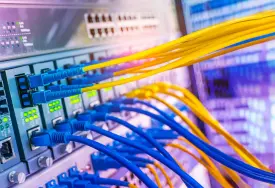Metro Detroit Structured Cabling Testing

At Detroit Field Techs, we understand that the backbone of any efficient business operation is a robust and reliable network infrastructure. Our structured cabling testing services are designed to ensure the optimal performance of your data network by meticulously assessing and validating all aspects of your cabling system. Using advanced testing equipment, our experienced technicians conduct thorough evaluations to identify and rectify any potential issues, ensuring your structured cabling meets industry standards and supports your business needs seamlessly.
Our commitment to excellence is evident in the precision with which we conduct cable and network certification. Detroit Field Techs' specialists are proficient in diagnosing discrepancies and ensuring that your cabling infrastructure can handle current and future data demands. We provide comprehensive reports and insights that help you understand the health of your network, enabling informed decisions for upgrades or expansions. This proactive approach minimizes downtime and enhances the efficiency of your operations, giving you peace of mind that your network infrastructure is in capable hands.
Serving businesses across the region, Detroit Field Techs takes pride in offering tailored solutions that cater to diverse commercial and industrial environments. Our structured cabling testing services are an integral part of our broader network solutions, which include fiber optic installation, wireless networking, and A/V systems. By focusing on delivering reliable and scalable network solutions, we empower businesses to stay connected and competitive in an ever-evolving technological landscape.
We bring a high level of expertise to every project, backed by years of industry experience. Please visit our work to see detailed examples of our completed projects and the high-quality standards we uphold.

Our team stays up-to-date with the latest network standards and installation practices, ensuring that your systems are cutting-edge and compliant. This means we use the most current technologies and methods to deliver reliable, efficient, and future-proof networking solutions.

We use only the highest quality copper, fiber, and AV products, ensuring superior performance and durability in all our installations. Each product is certified to meet or exceed manufacturers' specifications, guaranteeing optimal reliability and efficiency for your network.

Our data cabling projects are performed professionally, reliably, and with full accountability, giving you peace of mind and confidence in our services.
Upgraded a global financial services company’s WAN to an AT&T rate adjustable 100Mbps interstate-rated switched Ethernet circuit. Install flexible conduit from the parking garage telco room to the building interior. Pull 300’ CAT 5E CMP cable from AT&T demarc using the building’s existing conduit over the lobby and up to the tenant’s 3rd floor MDF...
Complete build-out of the cable plant for a national fine dining restaurant. Install flame-retardant telecom backboards in the electrical room. Install an 11U wall-mount open swing rack on the backboard. Ground rack to building UFER with #6 AWG. Core drill into the masonry block wall and install 1-¼ EMT sleeves. Build overhead cable support system in kitchen and dining...
Achieve higher bandwidth and faster data transfer rates for an investment bank branch’s Main Distribution Frame (MDF) to Immediate Distribution Frame (IDF) backbone. Pull (1) 6-strand armored fiber, 50 MIC MM OM4 cable and (4) CAT 6 CMP cables from 1st floor MDF to 1st floor IDF using existing cable pathways. Ground armored fiber to building UFER. Terminate, certify, and label all...
Complete network build-out of the appliances & kitchen cabinets department for a national home improvement retailer. Label existing data and voice cabling that connects to existing store terminals, printers, and phones. Reroute existing cabling to a temporary location. Move store terminals, printers, and phones to...